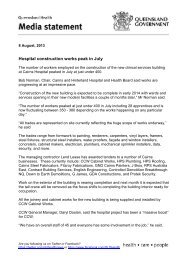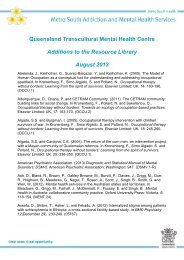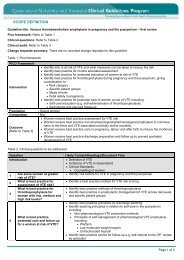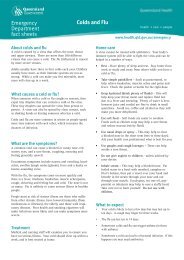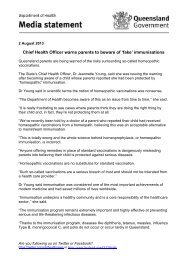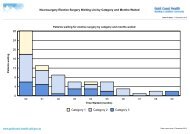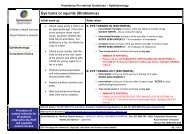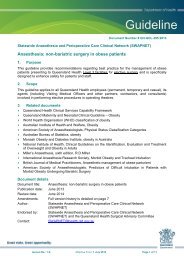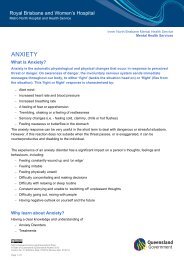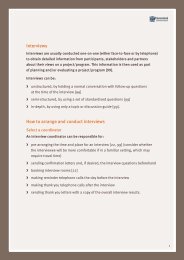Paediatrics - Queensland Health - Queensland Government
Paediatrics - Queensland Health - Queensland Government
Paediatrics - Queensland Health - Queensland Government
Create successful ePaper yourself
Turn your PDF publications into a flip-book with our unique Google optimized e-Paper software.
Gastrointestinal problems<br />
610<br />
Controlled copy V1.0<br />
Lactose intolerance<br />
Recommend<br />
Continue breastfeeding (lactase can be tried). For formula fed infants use low lactose<br />
formula<br />
Consider other causes of chronic diarrhoea<br />
Background<br />
Lactose intolerance commonly follows acute diarrhoea in Aboriginal and Torres Strait<br />
Islander children<br />
Related topics<br />
Acute gastroenteritis and dehydration<br />
Failure to thrive<br />
Nappy rash<br />
Child with chronic diarrhoea flow chart<br />
1. May present with<br />
• Chronic diarrhoea, bloating, vomiting, irritability<br />
• Stool may be “frothy”<br />
• Perianal area may be scalded<br />
2. Immediate management Not applicable<br />
3. Clinical assessment<br />
• Obtain a complete patient history<br />
• Perform standard clinical observations +<br />
-- weigh - use naked weight in young children - record against last recorded<br />
weight<br />
• Collect a faeces specimen for MC/S, OCP (ova, cysts and parasites) and reducing<br />
substances<br />
• Perform physical examination: See Clinical assessment of hydration in children<br />
-- palpate abdomen for tenderness or guarding<br />
-- inspect the perianal area for irritation of area<br />
4. Management<br />
• Consult MO if suspect lactose intolerance and refer to next MO clinic<br />
• Never restrict breastfeeding<br />
• Encourage extra fluids while the child continues to have diarrhoea<br />
• Avoid lactose based formulas and cows milk products:<br />
-- -lactase (Tilactase® [Lacteeze®]) can be used in breastfed infants before,<br />
during and after a breastfeed, but is not very effective because the enzyme<br />
takes about 30 minutes to breakdown the breast milk lactose, so there may<br />
not be enough contact time in the stomach<br />
-- an infant usually fed on lactose based formula or cows milk should be<br />
prescribed a low lactose formula as an alternative: De-Lact® or O-Lac®<br />
-- don’t use soy formulas<br />
• Reintroduce normal formula after 2 - 4 weeks starting with 1/3 normal to 2/3<br />
lactose free and increasing the proportion of normal formula over 3 - 4 days<br />
• If symptoms recur, revert to lactose free formula and try again in 2 - 4 weeks<br />
Primary Clinical Care Manual 2011



